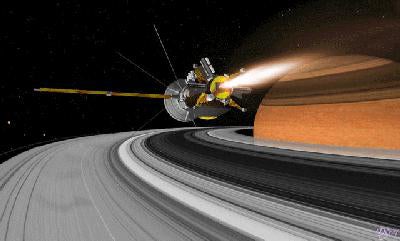Cassini Plasma Spectrometer (CAPS)
This instrument directly analyzes the energy and electrical charge of electrons, protons, and ionized atoms and molecules in Saturn’s environment. This will allow scientists to determine the configuration of the planet’s magnetic field, measure the composition of ionized particles originating from Saturn’s ionosphere as well as Titan, explore the interaction between the solar wind and the planet’s magnetic field, and study auroral activity in Saturn’s cloudtops.
Cosmic Dust Analyzer (CDA)
This instrument directly measures the size, speed, direction, and composition of tiny dust particles near Saturn. Some of these particles are in orbit around Saturn while others may come from other solar systems. The CDA will map the size distribution and composition of particles in and near the rings. Its ability to determine a particle’s trajectory will allow scientists to learn where in the saturnian system these grains of dust originated.
Composite Infrared Spectrometer (CIRS)
This instrument measures infrared radiation with wavelengths between 7 and 1,000 micrometers, allowing scientists to determine the composition and temperature of atmospheres, rings, and surfaces throughout the saturnian system. Specifically, CIRS will analyze the atmospheres of both Saturn and Titan and study hazes and clouds in those atmospheres. It will also determine the composition and temperature of Saturn’s rings and moons.
Ion and Neutral Mass Spectrometer (INMS)
This instrument measures the composition of both neutral and positively charged gases. Its main goal is to analyze the composition and structure of Titan’s upper atmosphere and to study that moon’s atmospheric chemistry.
Imaging Science Subsystem (ISS)
This instrument captures images in visible light as well as the near-ultraviolet and near-infrared and is designed to study the entire saturnian system. ISS consists of two cameras: one that takes broad, wide-angle pictures and one that records small areas in fine detail. Scientists expect ISS to return hundreds of thousands of images of Saturn, its rings, and its moons.
Dual Technique Magnetometer (MAG)
This instrument measures the strength and direction of magnetic fields. It will be used to determine the three-dimensional structure of Saturn’s magnetic field, which will allow scientists to probe the molten core of the planet where the magnetic field originates. It will also seek to find and characterize the magnetic fields of Titan and the icy moons.
Magnetospheric Imaging Instrument (MIMI)
This instrument images Saturn’s magnetosphere and measures the composition, charge, and energy of particles in the magnetosphere. This information will be used to study the overall configuration and dynamics of the magnetosphere as well as its interaction with the solar wind, Saturn’s atmosphere, the rings, Titan, and the icy moons.
Radio Detection and Ranging Instrument (RADAR)
This instrument uses Cassini’s high-gain antenna to direct radar transmissions toward targets and then captures the reflected signals. It consists of a synthetic aperture radar imager, an altimeter, and a radiometer. RADAR’s prime tasks are to determine whether oceans exist on Titan and, if so, to map their distribution, and to investigate the geologic features and topography of Titan’s solid surface.
Radio and Plasma Wave Science Instrument (RPWS)
This instrument measures the electric and magnetic fields in the saturnian system and the density and temperature of electrons in the planet’s magnetosphere. It will study the configuration of Saturn’s magnetic field as well as monitor and map the planet’s ionosphere and lightning discharges in the atmosphere.
Radio Science Subsystem (RSS)
This instrument uses radio telescopes on Earth to observe the way radio signals from Cassini change as they pass through different regions. This will allow scientists to study the composition, pressure, and temperature of the atmospheres of Saturn and its moons, and investigate the structure and particle size distribution in the rings. It can also search for gravitational waves coming from beyond the solar system and study the Sun’s corona and general relativity when Cassini passes behind the Sun.
Ultraviolet Imaging Spectrograph (UVIS)
This instrument measures the ultraviolet light reflected or emitted by atmospheres, rings, and moon surfaces. It will be used primarily to study the composition, chemistry, and circulation in the atmospheres of Saturn and Titan. UVIS will also observe the radial structure of the rings by scrutinizing starlight passing through them and analyze the surface ices and tenuous atmospheres of Saturn’s icy moons.
Visible and Infrared Mapping Spectrometer (VIMS)
This instrument takes images at both visible and infrared wavelengths to determine the composition, temperature, and structure of atmospheres, rings, and moon surfaces. It also will map the behavior of winds and eddies on Saturn and Titan, search for lightning in the atmospheres of those two worlds, and search for active volcanism on Titan.










